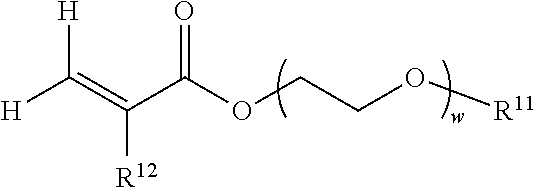Composite membranes
a technology of composite membranes and membranes, applied in the field of composite membranes, can solve the problem that membranes do not have a particularly good gas flux, and achieve the effect of improving the gas flux of membranes
- Summary
- Abstract
- Description
- Claims
- Application Information
AI Technical Summary
Benefits of technology
Problems solved by technology
Method used
Image
Examples
example 1
[0153]A length of porous support layer (GM-L-6) was spliced into a roll of laminated paper as guide that was fed as a web through a composite membrane manufacturing unit. The web moved at a speed of 30 m / min. Curable Composition A at 40° C. was applied continuously to the moving porous support layer by means of composition application station comprising a slide bead coating machine using just one of its slots. The coated support passed under an irradiation source (a Light Hammer LH6 from Fusion UV Systems fitted with a D-bulb working at 100% intensity) and then to a drying zone at 40° C. and 8% relative humidity. The dried, composite membrane then travelled to the collecting station.
[0154]A section through the resultant composite membrane was examined by a scanning electron microscope (SEM) and the discriminating layer was found to have a thickness of 1.5 μm.
example 2
[0155]The method of Example 1 was repeated except that two slots of the slide bead coating machine were used: One slot applied a 100 μm thickness lower layer of inert liquid (water) to the porous support, thereby filling the pores with inert liquid, and the other slot applied a 15 μm thickness layer of Curable Composition C to the wet porous support. The resultant discriminating layer was found to have a thickness of 0.925 μm.
examples 7 to 18
[0158]Examples 1 to 6 may be repeated except that in place of Curable Composition A or C there is used Curable Composition B or D.
Tests and Results
[0159]The support layers and the composite membranes prepared in the Examples 1 to 6 and Comparative Examples 1 and 2 were tested as follows.
(A1) Measuring the CO2 Gas Flux of the Porous Support Layers
[0160]Samples of the porous support layers under examination were set into a Millipore membrane cell with an area of 13.8 cm2. CO2 gas at room temperature at a feed pressure of 2.07 kPa was applied to one side of the porous support material and the flow rate of gas permeating through the other side of the membrane (JsCO2) was measured using a digital flow meter. The CO2 gas flux of the support (QsCO2) in m3 (STP) / m2·s·kPa at a feed pressure of 2.07 kPa was then determined by the following calculation:
QsCO2=JsCO2 / (A×p)
wherein:
[0161]JsCO2 is the flow rate of CO2 in m3 / s;
[0162]A is the membrane area in m2; and
[0163]p is the feed pressure in kPa...
PUM
| Property | Measurement | Unit |
|---|---|---|
| Fraction | aaaaa | aaaaa |
| Fraction | aaaaa | aaaaa |
| Fraction | aaaaa | aaaaa |
Abstract
Description
Claims
Application Information
 Login to View More
Login to View More - R&D
- Intellectual Property
- Life Sciences
- Materials
- Tech Scout
- Unparalleled Data Quality
- Higher Quality Content
- 60% Fewer Hallucinations
Browse by: Latest US Patents, China's latest patents, Technical Efficacy Thesaurus, Application Domain, Technology Topic, Popular Technical Reports.
© 2025 PatSnap. All rights reserved.Legal|Privacy policy|Modern Slavery Act Transparency Statement|Sitemap|About US| Contact US: help@patsnap.com

